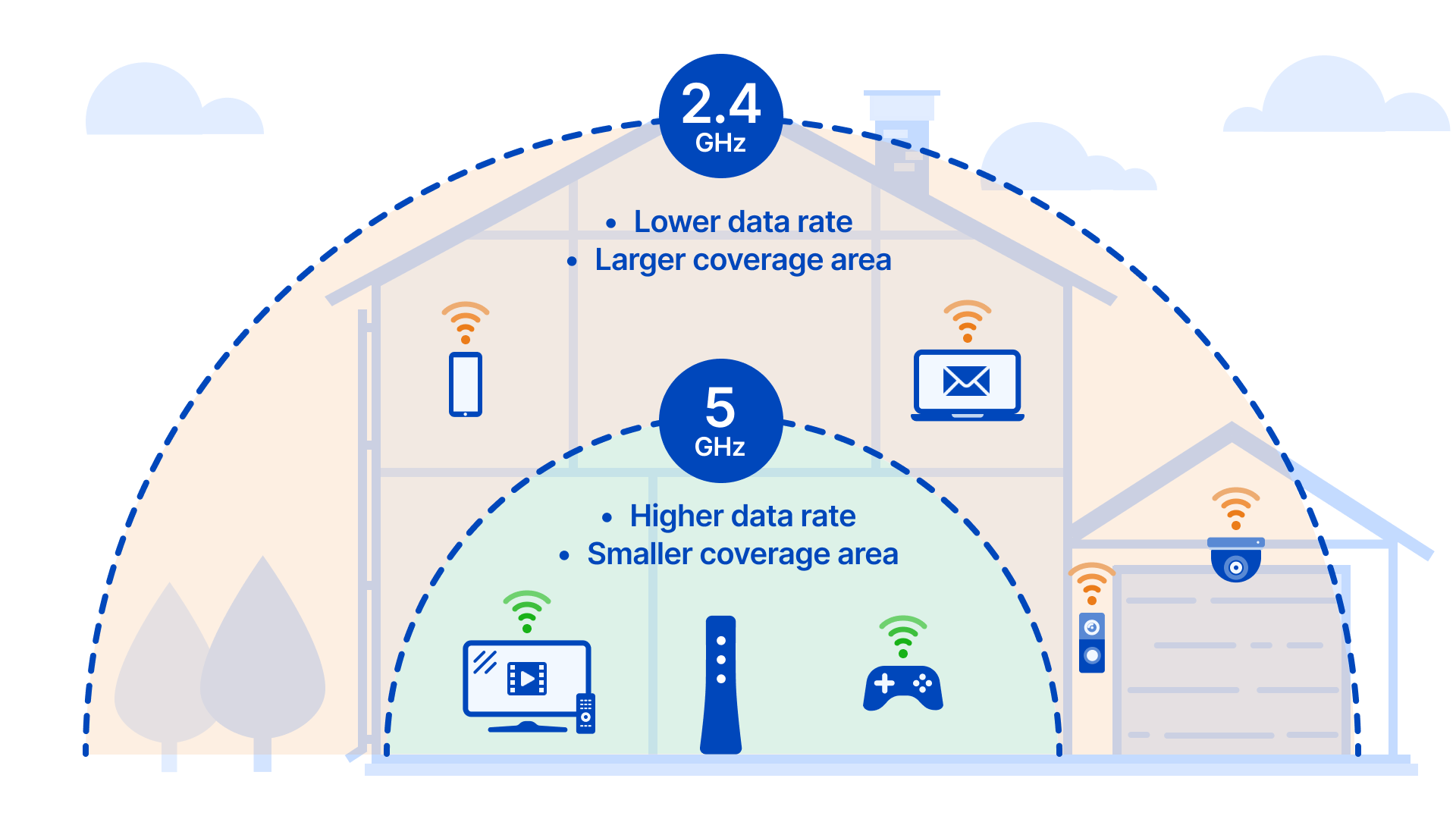You probably have both 2.4 GHz and 5 GHz Wi-Fi on your router. Wi-Fi signals are transmitted by wireless routers at frequencies of 2.4 GHz and 5 GHz. A faster and more reliable internet connection can be achieved by choosing the right WiFi frequency band for your situation. We will examine the strengths, weaknesses, and best uses of 2.4GHz and 5GHz Wi-Fi.
2.4 GHz Wi-Fi
Pros
-
Wi-Fi with greater range than 5 GHz
-
Walls and obstructions are more reliable
Cons
-
Wi-Fi at 5 GHz is slower
-
Interference-prone
5 GHz Wi-Fi
Pros
-
Wi-Fi with a faster speed than 2.4 GHz
-
Interference-resistant
Cons
-
Wi-Fi with a lower range than 2.4 GHz
-
Reliability is worse through walls and obstructions
You will have a better range and better signal penetration through walls and other obstacles when using the 2.4 GHz Wi-Fi frequency band. There is much more speed available on the 5 GHz frequency band of Wi-Fi. When used with the right router and the latest Wi-Fi standard, 2.4 GHZ Wi-Fi can reach 600 Mbps under ideal conditions. For an average home network, a 2.4GHz Wi-Fi connection can deliver a maximum speed of 150 Mbps.
More than double the speed is possible with a 5 GHz Wi-Fi connection. It’s also easier to avoid interference caused by other devices and routers with 5GHz Wi-Fi.

Use 5 GHz Wi-Fi if you have a strong Wi-Fi signal
5 GHz Wi-Fi is faster and more resistant to interference from other wireless devices and routers. Due to its shorter range and inability to pass through walls and obstructions, 5 GHz W-Fi has a lesser range than 2.4 GHz W-Fi. There’s no reason to not use 5 GHz Wi-Fi if your device’s Wi-Fi meter shows three or more bars. Any situation where you are in range of other routers, such as an apartment complex or a living situation where there are other routers, may require this device.
Use 2.4 GHz Wi-Fi when you can’t use 5 GHz Wi-Fi
There is only one time when you should use 2.4GHz Wi-Fi, and that is if you cannot effectively use 5GHz Wi-Fi. You may be able to get a better signal by switching to 2.4 GHz Wi-Fi if you are out of 5 GHz Wi-Fi’s effective range or getting a spotty signal due to thick walls.
2.4 GHz Wi-Fi explained
2.4 GHz Wi-Fi frequency bands use lower frequencies than 5 GHz Wi-Fi frequency bands, which explains why 2.4 GHz Wi-Fi penetrates solid objects better and gives you more Wi-Fi range.
Many devices, such as microwaves, garage door openers, and baby monitors, use the 2.4 GHz frequency band. In addition to introducing interference to 2.4GHz Wi-Fi, these devices can also slow it down or interrupt it.
Your 2.4 GHz Wi-Fi can also be interfered with by other routers broadcasting on the same radio frequencies. There are 14 channels in the 2.4 GHz frequency band. In order to broadcast your Wi-Fi, your router chooses one of these channels automatically. The Wi-Fi signal may be interfered with if another router broadcasts Wi-Fi on the same channel in the same area. Multi-router apartment buildings are especially prone to this problem, as they have a large number of routers in close proximity to each other.
5 GHz Wi-Fi explained
In contrast to 2.4 GHz Wi-Fi, 5 GHz Wi-Fi broadcasts Wi-Fi at higher frequencies, and these higher frequencies are not able to travel through walls and solid objects as well as the lower frequencies of 2.4 GHz Wi-Fi. Therefore, 2.4 GHz Wi-Fi has a shorter range than 5 GHz Wi-Fi.
Due to its newer, more effective standard (Wi-Fi 5), 5 GHz Wi-Fi is much faster than 2.4 GHz Wi-Fi. Additionally, because of the 5 GHz Wi-Fi frequency band’s more channels and relative isolation from other devices, like garage door openers and cordless phones, it is less prone to interference than 2.4 GHz.
What do 2.4 GHz and 5 GHz mean?
Wireless routers transmit Wi-Fi signals using the 2.4 GHz and 5 GHz frequency bands. These days, most routers broadcast on both frequency bands, meaning they are dual-band routers. According to the frequency spectrum, the 2.4 GHz and 5 GHz bands begin at 2,401 GHz and 5,180 GHz, respectively.
Is 2.4 GHz or 5 GHz better?
If speed is important to you, choose 5 GHz Wi-Fi, which uses newer technology and is faster. A 2.4 GHz Wi-Fi signal will generally get through obstacles better over a wider area if you need range. Since each excels at a different task, it’s best to choose the Wi-Fi type that best meets your current needs rather than comparing 2.4 GHz with 5 GHz. For example, a 5 GHz Wi-Fi connection won’t help you if you’re out of range or the signal is obstructed.
What is Wi-Fi 6E?
Using the 6 GHz frequency band is a new feature of Wi-Fi 6E. With these newly designated frequencies, Wi-Fi speeds have been increased even further, but there are two big caveats: First, you must have a router and devices that support Wi-Fi 6E, so Wi-Fi 6E can only be used with new devices. In addition, Wi-Fi 6E has a very short range, so it’s recommended that you only use it when you’re within the same room as the router.
With that in mind, if you’re looking for a new router, you should try to find one that supports Wi-Fi 6E; as more devices support the standard, it is sure to become a valuable feature.
What are Wi-Fi frequency bands?
Data is transmitted to wireless devices through Wi-Fi routers using radio frequencies. 2.4 GHz and 5 GHz are two groups of radio frequencies (2.4 GHz and 5 GHz). Dual-band routers can transmit over both the 2.4 GHz and 5 GHz Wi-Fi bands, which is why they are called dual-band routers.
Channels are formed by the division of radio frequencies between the 2.4 GHz and 5 GHz bands. To transmit your internet signal, your Wi-Fi uses one of these channels. A 5GHz Wi-Fi network has 42 channels, while a 2.4GHz Wi-Fi network has only 14. Due to the fact that 5 GHz Wi-Fi has more lanes, Wi-Fi traffic jams are not a big problem.



